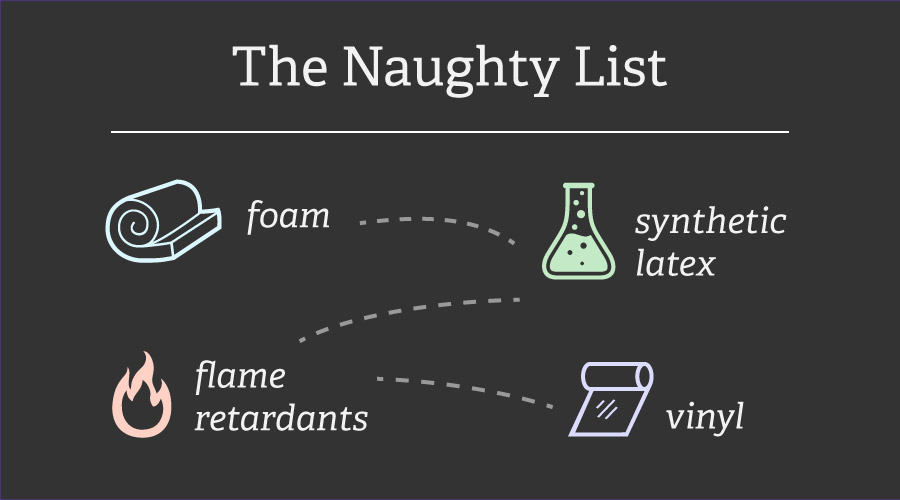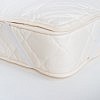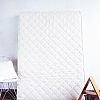One of the most surprising things about toxic chemicals in mattresses is how incredibly common they are. In fact, mattresses that are off-gassing harmful VOCs, and emitting toxic chemicals seem to be the norm, and not the exception. Even worse, this is true even of many mattresses claiming to be “organic” or “all-natural.”
How can this be? Why do mattress companies use materials known to be toxic? How can you protect yourself and your family from exposure?
In this article, we’ll show you 4 common mattress materials that you should avoid. We’ll show you exactly why you should avoid them. And we’ll show you why manufacturers are still using these toxic chemicals, despite their health risks.
So let’s begin our countdown of common, but toxic mattress materials.
1. Foam
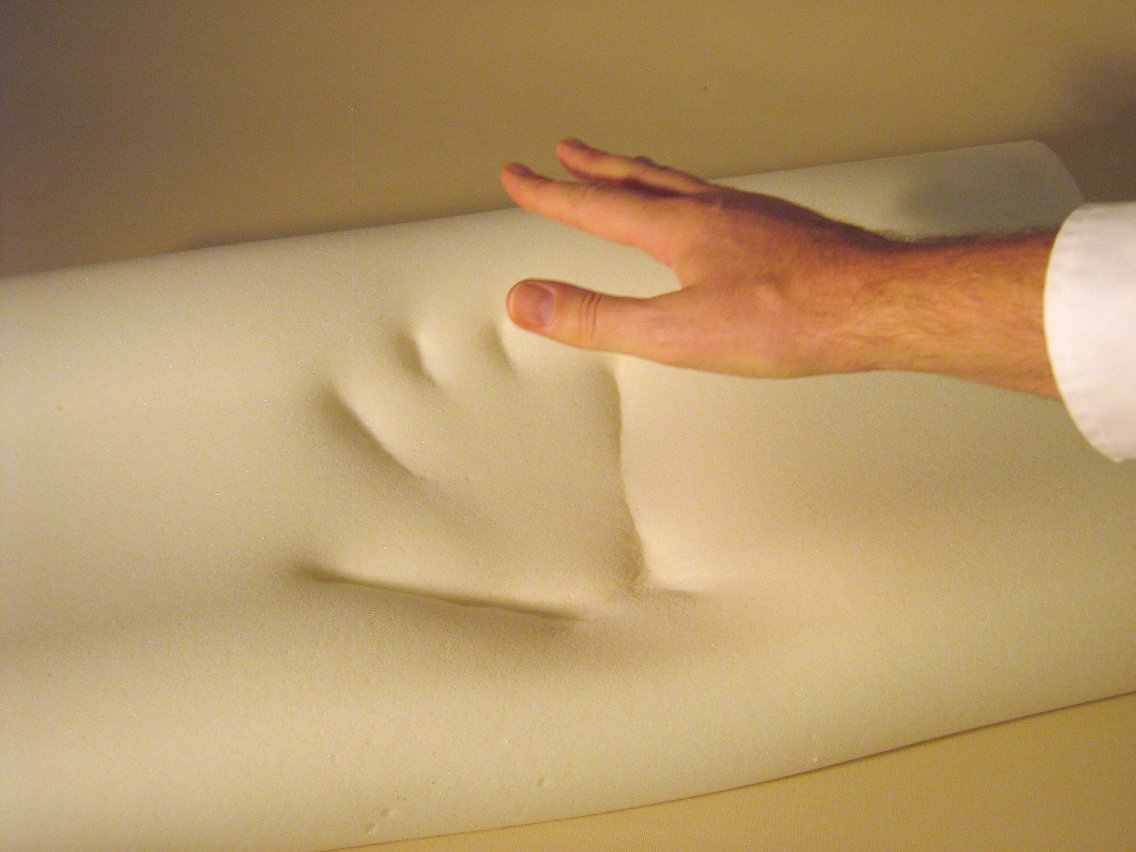
Foam is made from petroleum using a “witches brew” of toxic chemicals. Over time, volatile organic compounds (VOCs) from foam are released into the air where you are exposed to them. Also, because foam is highly flammable, a large amount of toxic flame retardants are often added. Foam is still widely used in mattresses because it is cheap to produce.
What Makes Foam Toxic?
Both Polyurethane Foam and Memory Foam are petroleum-based. First, that means they are made with a “witches brew” of toxic chemicals (more on that soon). Second, they break down over time, causing major off-gassing of VOCs into the air you breath. And third, they are extraordinarily flammable. Some fire marshals have even nick-named foam “Solid Gasoline.” As a result, these beds are often soaked in the most powerful and dangerous chemical flame retardants.
How Can Foam Affect Your Health?
The harmful chemicals used to make foam break down over time. In fact, a polyurethane foam mattress loses HALF its weight over ten years of use! [source]. Where does the weight go? It’s released into the air around you and you breathe in this chemical dust.
How can these chemicals harm you? Here’s a short list:
- Propylene oxide and TDI (two chemicals used to make Polyurethane Foam) have been shown to cause mammary tumors. [Sources: Propylene oxide,TDI]
- Toluene, a neurotoxin, off-gasses from polyurethane foam products. [Source]
- The EPA considers polyurethane foam fabrication facilities potential major sources of several hazardous air pollutants including methylene chloride, toluene diisocyanate (TDI), and hydrogen cyanide. [Source]
- The VOCs off gassed from foam can irritate the eye, nose, and throat, cause headaches, loss of coordination, and nausea, and damage the liver, kidney, and central nervous system.
- Some VOCs may even cause cancer, after prolonged exposure.
- Also, because foam is extra flammable, foam mattresses are usually drenched in harmful, chemical flame retardants (we’ll get to that in a minute).
Why do Manufacturers Still Use Foam?
Foam is widely used in mattresses because it is inexpensive and lightweight.
How do Manufacturers Market Foam?
There are two-ways mattresses companies try to market foam, but don’t be fooled.
First, mattress companies will claim that their mattress uses “Plant-based foams.” But what they don’t tell you is that they only use a small percentage of plant oil (5-20%). The other 80-95% is still good ‘ol Polyurethane Foam! So what they are really making is Polyurethane Foam mattresses with a tiny bit of plant oils added for marketing purposes! [Source]
The second marketing strategy for foam is the “CertiPUR-US” certification. Guess who came up with the guidelines? According to CertiPUR-US’s own literature, “The Guidelines were established with guidance from the global foam industry.” That’s right. The global foam industry created their own guidelines for certifying that their foam is safe. That would be like letting the Global Tobacco Industry create their own guidelines for “safer cigarettes.” Not surprisingly, the CertiPUR-US certification still allows for VOC emissions!
2. Synthetic Latex
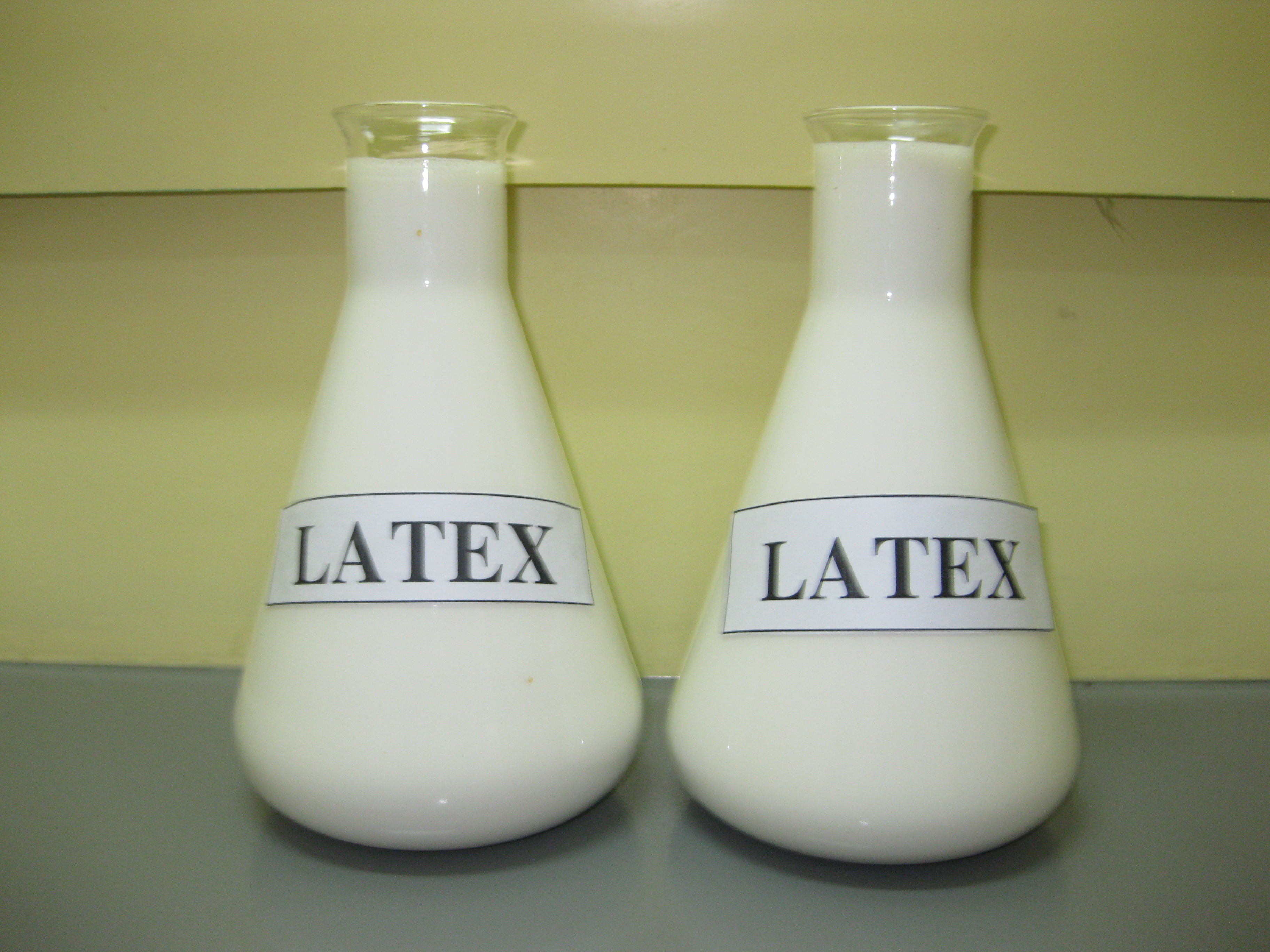
Synthetic Latex is made from two petroleum-based compounds which can pose serious health risks. Look instead for “100% Natural Latex.”
What Makes Synthetic Latex Toxic?
Synthetic Latex is made from two petroleum-based compounds, styrene and butadiene. Both of these are VOCs and can do serious harm. Also, additional toxic chemicals may be used during processing.
How Can Synthetic Latex Affect Your Health?
According to the EPA, chronic exposure to the first ingredient, styrene, can have some serious consequences, including the following [Source for below]:
- Effects on the central nervous system (CNS)
- Headache, fatigue, weakness, and depression
- Hearing loss
- Peripheral neuropathy
- An increased risk of leukemia and lymphoma.
And the second ingredient, Butadiene, harms the nervous system, irritate eyes and skin, and may cause cancer. [Source]
Why Do Manufacturers Use Synthetic Latex?
Synthetic Latex is WAY cheaper to produce than natural latex. It can be made simply and cost effectively in a laboratory. Natural latex requires growing and harvesting the Hevea-Brasiliensis tree (better known as a rubber tree), which is time-consuming and costly.
How do Manufactures Market Synthetic Latex?
Similar to foam mattresses, companies will often start with synthetic latex, then add a bit of natural latex. They then will market the blended latex as “natural latex,” even though it is still primarily synthetic latex. Don’t be fooled. Be sure to look for 100% Natural Latex. If the company doesn’t clearly specify the percentage, they are probably blending it.
3. Chemical Flame Retardants

Chemical flame retardants, like Antimony, Boric Acid and Halogenated Flame Retardants have been linked to various health problems, some severe.
Why Are Chemical Flame Retardants Toxic?
Because Chemical Flame Retardants don’t fully bind to materials, they are released over time into your bedroom. Exposure to these chemicals has been linked to serious lifelong health problems.
How Can Chemical Flame Retardants Affect Your Health?
The most common Chemical Flame Retardants are Antimony, Boric Acid, and Halogenated Flame Retardants (HFRs). Antimony is a toxic heavy metal which can cause eye, heart, and lung problems. Boric Acid (also called Borate Powder) can cause eye and respiratory irritation. Halogenated Flame Retardants may be the worst of the bunch. They are linked to severe problems that can span generations. Here’s a few of the effects found from studies of HFRs :
- Delay puberty, delay reproductive development & cause neurobehavioral changes [Source: US Department of Health and Human Services]
- Disrupt thyroid hormones [Source: National Center for Biotechnology Information]
- May cause Cancer and demonstrated to harm sperm and their mobility, even across two generations [Source: International Archives of Occupational and Environmental Health]
- Harm brain and nerve function. [Source]
Why Do Manufacturers Use Chemical Flame Retardants?
Mattress companies add these chemical flame retardants because it is an inexpensive way to meet federal flammability standards. There are alternatives to chemical flame retardants. For instance, Wool is able to act as a natural flame retardant, but this is more expensive and time-consuming to produce, and thus not commonly used.
How Manufacturers Market Chemical Flame Retardants:
Unfortunately, Mattress companies are not required to disclose what flame retardants they are using. And it is especially difficult to know exactly what is inside when the company is using a “proprietary” formulation. So unless a mattress company is explicitly eliminating the use of chemical flame retardants, and using a natural solution like Wool, they are likely using one of the harmful chemicals listed above.
4. Vinyl

Vinyl production uses toxic chemicals and additives which have been linked to major health issues
Why is Vinyl Toxic?
The production of Vinyl uses toxic, harmful chemicals from start to finish. These chemicals, which have been shown to cause severe health problems, leach out during use.
How Can Vinyl Affect Your Health?
Common additives used in making Vinyl include Phthalates and heavy-metals (like Antimony, mentioned above). Phthalates have been shown to:
- Trigger asthma and allergies [Source]
- Cause genital defects including male feminization [Source: National Research Council]
- Alter child behavior [Source]
Another problem with Vinyl is that a chemical called Dioxin is released during production. Dioxin has been shown to:
- Cause cancer
- Cause birth defects
- Harm developing brains
Why Do Manufacturers Use Vinyl?
Vinyl is a cheap way for manufacturers to make beds waterproof & bacteria resistant. Sadly, this makes them especially common in baby mattress!
How Do Manufacturers Market Vinyl?
If a mattress claims to be waterproof, there is a good chance they are using vinyl since it is one of the cheapest ways to do this. Be sure to ask mattress companies if they use any vinyl in their mattresses. They aren’t required to list this, so there is a chance it is present, even if not listed.
How Can You Avoid These Toxic Chemicals?
One of the most frustrating things about buying mattresses is the lengths that mattress companies go to hiding the toxic-chemicals from you. You’ve seen in the above article just a few a the ways that mattress companies attempt to fool you into thinking their mattress is safe, when nothing could be further from the truth. And the leniency of federal regulations in the U.S. certainly doesn’t help the situation.
That’s one reason that here at SleepLily, we created our own Non-Toxic Promise, which clearly lays out that we are not using ANY toxic chemicals in our mattresses. Also, in the descriptions of our non-toxic mattresses, we show you EXACTLY what we use inside the mattress. We believe in transparency & honesty, so you know precisely what you are getting when you buy a SleepLily mattress, and you can have confidence knowing that you are making a good investment for the future.
After all, we created SleepLily because it’s the mattress we wanted for our own family!
But regardless of what mattress company you choose, we want to make sure you have all the information you need to make an informed decision. If you have any questions, or need recommendations, please don’t hesitate to contact us!

